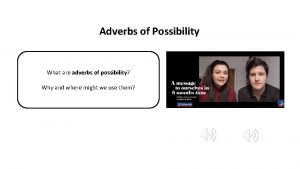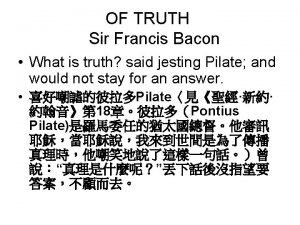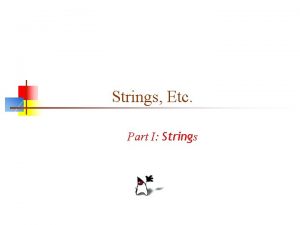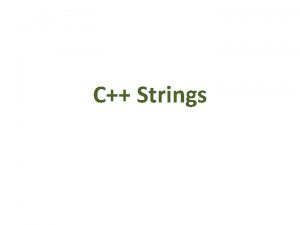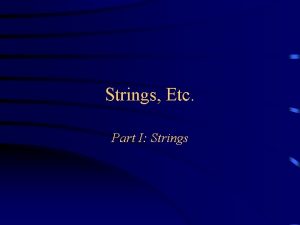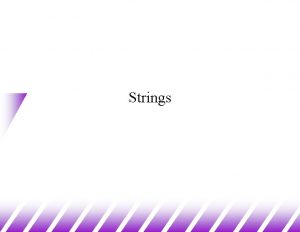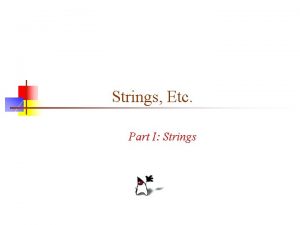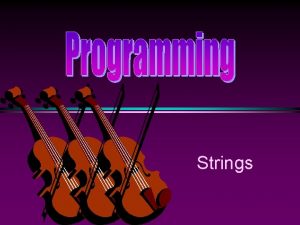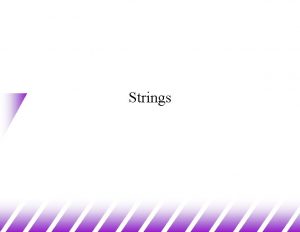Numerical Representation of Strings You certainly noticed that









- Slides: 9

Numerical Representation of Strings You certainly noticed that in our string representation we used symbols s 1, …, sn, while in the everyday number representation we use s 0, …, sn-1. So what exactly are the analogies and differences between the two systems? To find out about this, let us look at the following modified set of digits D: D = {s 1, …, s 10} = {1, 2, 3, 4, 5, 6, 7, 8, 9, X} Here, the X stands for a digit with the value 10, while there is no digit with the value 0. April 18, 2019 Theory of Computation Lecture 18: Calculations on Strings III 1

Numerical Representation of Strings So what is the number x associated with the string w = 76 ? x = 7 10 + 6 = 76 And what is the number for w = 3 X 6 ? x = 3 100 + 10 10 + 6 = 406 Finally, what is the number for w = XX ? x = 10 10 + 10 = 110 These examples already suggest that we can use this system in a way quite similar to our “usual” system. April 18, 2019 Theory of Computation Lecture 18: Calculations on Strings III 2

Numerical Representation of Strings Now let us turn this around: What is the string w associated with the number x = 39? w = 39 (as long as x does not contain any 0 s, w is the “usual” decimal string representing x) And what is the string for x = 100 ? w = 9 X But what is the string for x = 504 ? w = 4 X 4 Finally, what is the string for x = 0 ? w = 0 (0 is the null string symbol) April 18, 2019 Theory of Computation Lecture 18: Calculations on Strings III 3

Numerical Representation of Strings We can even transfer our elementary arithmetic to the new system: X 4 +596 6 9 X X 23 - X 1 X 3 April 18, 2019 corresponding to 104 +596 700 1023 - 1020 �� 3 Theory of Computation Lecture 18: Calculations on Strings III 4

Numerical Representation of Strings This applies even to multiplication: 3 X X 7 2 7 X 3 9 X ��� 4 2 7 X April 18, 2019 corresponding to 40 � 1 0 7 4280 Theory of Computation Lecture 18: Calculations on Strings III 5

Numerical Representation of Strings So you see that we can easily replace our usual digit range from 0 to n-1 with the range 1 to n. In our representation of strings on the alphabet A, we use the range from 1 to n to have a bijective mapping between strings and numbers. When using a range from 0 to n-1, there is no such mapping, because different strings correspond to the same number, for example: 87 = 0087 = 00087 = … April 18, 2019 Theory of Computation Lecture 18: Calculations on Strings III 6

Numerical Representation of Strings Now let us return to our general case of associating numbers with strings. For an alphabet A = {s 1, …, sn}, the string w = sik-1 … si 1 , si 0 is called the base n notation for the number x as defined by x = ik nk + ik-1 nk-1 + … + i 1 n 1 + i 0. When n is fixed, we can consider a function of one or more variables on A* as a function of the corresponding numbers. April 18, 2019 Theory of Computation Lecture 18: Calculations on Strings III 7

Numerical Representation of Strings So we can speak of an m-ary partial function on A* with values in A* as being partially computable, or when it is total, we can speak of it as being computable. Similarly, we can say that an m-ary function on A* is primitive recursive. But what about predicates? Notice that for an alphabet A = {s 1, …, sn} the value s 1 denotes 1 in base n notation. Thus an m-ary predicate on A* is simply a total m-ary function on A* whose values are either s 1 (“true”) or 0 (“false”). Therefore, it makes sense to speak of an m-ary predicate on A* as being computable. April 18, 2019 Theory of Computation Lecture 18: Calculations on Strings III 8

Numerical Representation of Strings For a given alphabet A, any subset of A* (any set of strings on A) is called a language on A. By associating numbers with the elements of A*, we can speak of a language on A as being r. e. , recursive, or primitive recursive. Notice that our base n notation even works for n = 1, that is, an alphabet containing only one symbol. For example, if A = {s 1} then x = 1 is represented by the string w = s 1 x = 7 is represented by the string w = s 1 s 1 s 1 s 1 : April 18, 2019 Theory of Computation Lecture 18: Calculations on Strings III 9
